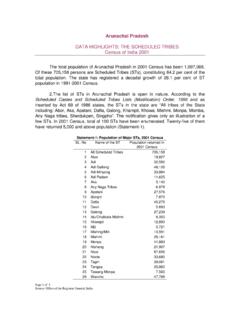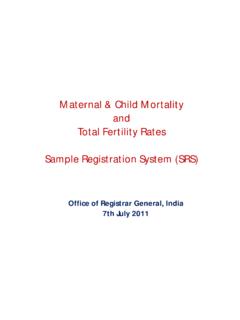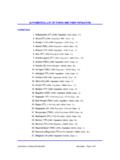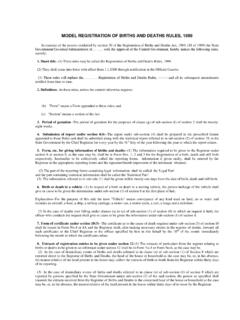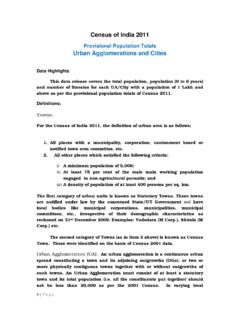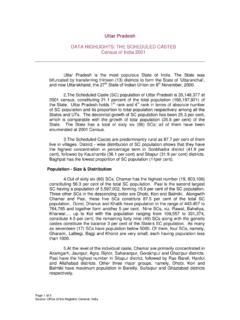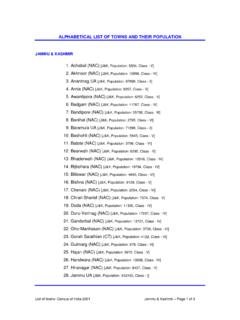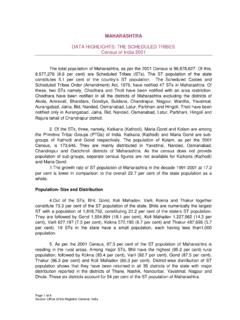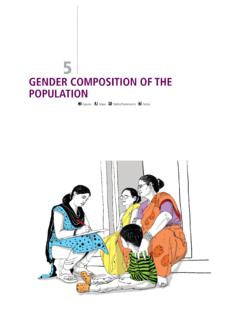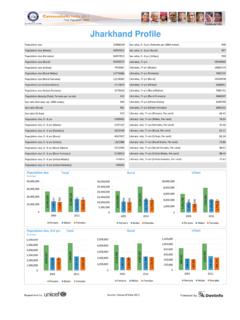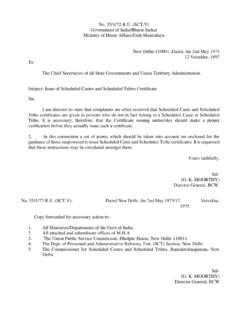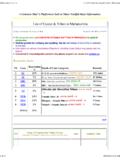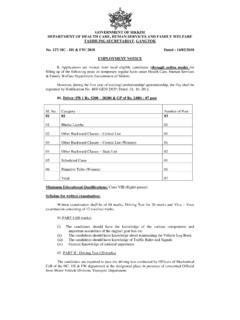Transcription of Introduction - Census of India Website
1 1 The relevant Articles dealing with the scheduled Castes (SCs) & scheduled Tribes (STs) in theConstitution of India provide for as under : scheduled Castes 341. (1) The President may with respect to any State or Union territory, and where it is a State, afterconsultation with the Governor thereof, by public notification, specify the castes, races ortribes or parts of or groups within castes, races or tribes which shall for the purposes of thisConstitution be deemed to be scheduled Castes in relation to that State or Union territory,as the case may be.
2 (2) Parliament may by law include in or exclude from the list of scheduled Castes specified ina notification issued under clause (1) any caste, race or tribe or part of or group within anycaste, race or tribe, but save as aforesaid a notification issued under the said clause shallnot be varied by any subsequent notification . scheduled Tribes 342. (1) The President may with respect to any State or Union territory, and where it is a State, afterconsultation with the Governor thereof, by public notification, specify the tribes or tribalcommunities or parts of or groups within tribes or tribal communities which shall for thepurposes of this Constitution be deemed to be scheduled Tribes in relation to that State orUnion territory, as the case may be.
3 (2) Parliament may by law include in or exclude from the list of scheduled Tribes specified in anotification issued under clause (1) any tribe or tribal community or part of or group withinany tribe or tribal community, but save as aforesaid a notification issued under the saidclause shall not be varied by any subsequent notification .2. For discharging constitutional obligation, Census Organization has been collecting data on SCsand STs population since 1951. The Primary Census Abstracts (PCA) of the SCs (Table A-8) and STs (TableA-9) population of 2001 Census at district, state and aggregated at the national level, have been publishedfor each State/UT.
4 The present volume contains individual caste-wise ( scheduled ) and tribe-wise ( scheduled )PCA for each State/UT. The information is about their population as well as child population, literacy andwork participation of each SC and ST by sex and residence presented in A-10 & A-11 Tables. This will beuseful for micro level policy planning as well as academic historical perspective3. An overview of the historical perspective of presentation of caste & tribe wise data shows that priorto 1931 Census , information was collected and published for each of the castes and tribes separately.
5 Atthe 1931 Census , tabulation of data for individual communities was limited to: (i) exterior castes,(ii) primitive castes and (iii) all other castes with the exception of (a) those whose members fell short of fourper thousand of the total population and (b) those for which separate figures were deemed to be unnecessaryby the local At the 1941 Census , group totals were tabulated for scheduled Castes/Tribes and totals were provided only for a few selected individual When preparations for the 1951 Census were undertaken, the Government of India had acceptedthe policy of official discouragement of community distinctions based on caste.
6 It was decided, therefore, thatno general race, caste or tribe enquiries would be made but an enquiry would be made regarding race, casteor tribe only to the extent necessary for providing information relating to certain special groups of the peoplewho are referred to in the Constitution of of scheduled Castes (SCs) & scheduled Tribes (STs) population :6. In each decennial Census since 1951, SCs and STs population have been enumerated strictly inaccordance with the Constitution ( scheduled Castes) Order, 1950 and the Constitution ( scheduled Tribes)Order, 1950, as amended from time to time.
7 These Presidential Orders contain the list of SCs and STsseparately for each State/UT and which are valid within its jurisdiction. At the 2001 Census , the ScheduledCastes and scheduled Tribes Orders (Amendment) Act, 1976 was in force in most of the , the Constitution ( scheduled Castes) Orders (Amendment) Act, 1990 which pertains to modificationin paragraph 3 of the Constitution ( scheduled Castes) Order, 1950, was strictly followed for the purpose ofenumeration of SCs population in the country. The State/UT wise SCs and STs list used at the time ofcensus operations is at At the 1991 Census , two questions were included in each of the Household Schedule and IndividualSlip.
8 While through question 10 of Household Schedule and question 9 of Individual Slip, inquiry was madein regard to SC/ST status of the person, the name of the SC/ST was enquired through question 11 of theHousehold Schedule and question 10 of the Individual Slip. Against this, at the 2001 Census , informationon the SCs & STs was ascertained through question numbers 8 & 9 of the Household Schedule. Thequestion 8 enquired, If scheduled Caste, write name of the SC from the list supplied. It was clarified thatthe SCs can be only among Hindus, Sikhs and Buddhists.
9 Whereas question 9 enquired, If ST, write nameof the ST from the list supplied . It was clarified that the STs can be from any religion. There was thus amajor departure from the past in respect of designing/formatting of questions in the Census schedule to elicitinformation on SCs/STs as well as the procedure followed for determining their population. One of thereasons for it was the adoption of advanced technology to scan the Census schedules through high speedscanners and create ASCII records by converting the hand-written data from the schedules into digitizedform through Intelligent Character Reading (ICR) software for further processing of Census Under the constitutional order, 1950 as amended in 1990, SCs can be only from Hindus, Sikhsand Buddhists while STs can be from any of the religions.
10 The question on religion of each individual wascanvassed through question The SC/ST status of each member of household was ascertained byasking whether she or he belonged to SC or ST. If the reply to either of this question was in the affirmative,the name of caste/tribe to which the individual belonged was recorded, provided the name of caste/tribereturned featured in the approved list for the State/UT. The enumerator was supposed to record faithfully inthe Household Schedule, the name of SC/ST as revealed by the Specific instructions were given to the Census enumerators to tally the name of caste/tribe returnedby the respondents with the names in the SCs/STs list supplied before it is recorded under the appropriatecolumn of the Household Schedule.
